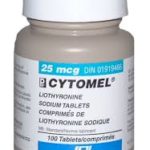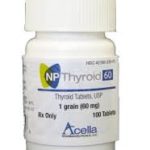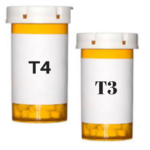About the different types of hypothyroid medications
Learn here about different hypothyroid medications! Become informed.
Most problematic, say years of patient reports: 1) Synthetic T4-only, meaning having NO T3 with the T4, which is the problem: Names include Synthroid, Levothyroxine/Levo, Tirosent, Oroxine, Extroxin and more.
T4, a storage hormone, is one of five thyroid hormones, which includes T4, T3, T2, T1 and calcitonin. It’s meant to convert to the active T3. But in a healthy thyroid, you are not forced to live for conversion alone–you also get direct T3. Some state they notice improvements on T4-only, while others state they never notice any improvements. But the common thread with the vast majority who force their bodies to live for conversion alone is that sooner or later, it backfires, leaving you with lingering hypothyroid symptoms and problems which vary from individual to individual. Many also report finding themselves with adrenal problems from being on T4-only, as well as lowered nutrients like iron, B12 and more. T4-only meds are taken once a day. They are the most problematic of hypothyroid treatments, based on years of patient reports and experiences. Read Chapter 1 in the updated STTM book–it will open your eyes. For more info, go here.
 Much better as the active hormone–has a short half-life. 2) Synthetic T3-only: Names include Cytomel, Cynomel, Tertroxin, Linomel, Cyronine, Unipharma, Ti-Tre, Tironina, Tiromel, Trijodthyronin and more.
Much better as the active hormone–has a short half-life. 2) Synthetic T3-only: Names include Cytomel, Cynomel, Tertroxin, Linomel, Cyronine, Unipharma, Ti-Tre, Tironina, Tiromel, Trijodthyronin and more.
This medication represents the active thyroid hormone T3–the hormone which brings back energy, metabolism, good health, etc. A healthy thyroid also gives direct T3 in addition to conversion of T4 to T3. If one is on T3-only, it’s generally taken three times a day, such as morning, then four hours later, then four hours later. Some will take a tiny amount at bedtime, but it’s individual. T3-only has a short half-life, thus multi-dosing. Using T3-only is about finding one’s optimal dose, which tends to put the free T3 at the top of the range, but optimal cortisol levels are important to prevent pooling. If one raises T3-only without having optimal levels of cortisol, the free T3 tends to go high without relief of symptoms. Treatment with T3 is never about the TSH, which will drop quite low and is not a problem as doctors wrongly claim. It’s a rougher treatment than having some additional T4 in one’s treatment, but can work quite well, say patients. Some people will add T3 to lower doses of NDT (#4 below) if they find themselves with high reverse T3, the inactive hormone—which will go up due to inadequate iron levels (not ferritin!! This is about serum iron!), or chronic inflammation, or Lyme disease, etc. Others have RT3 so high that they go solely on T3-only for awhile.
3) Combination of the above Synthetic T4 and Synthetic T3
These are generally combined and taken twice a day at a minimum to spread out the direct T3, such as first thing in the morning, then early afternoon. Works well if raised to find one’s optimal dose, the latter which puts the free T3 towards the top part of the range and free T4 mid-range. Optimal will also lower the TSH quite low, which is NOT a problem. Important to have adequate iron and cortisol to avoid problems with raising. Preferred by those who might have reasons to avoid porcine or bovine meds as in #4 below. Also used by those when doctors are clueless about Natural Desiccated Thyroid.
 4) A working Natural Desiccated Thyroid, aka NDT
4) A working Natural Desiccated Thyroid, aka NDT
NDT has been around for decades–since the late 1800’s. Most NDT comes from porcine (pig) thyroid; many over the counter versions come from bovine (cow), but there is no regulation. NDT contains all five thyroid hormones, T4, T3, T2, T1, and calcitonin. NDT porcine powder, used to make the pills by prescription, usually meets the strict guidelines of the US Pharmacopoeia. Good iron levels and cortisol are important to avoid problems when raising NDT (or T4/T3). Low iron causes T4 to convert to RT3, the inactive hormone. Adrenal issues causes T3 to go high in the blood, called pooling. Optimal puts the free T3 towards the top of the range (though pooling can be at the top, too, but with symptoms) and the free T4, midrange. The TSH will fall below range on NDT or T3 and contrary to the poor training of many doctors, is NOT hyperthyroidism. Study Chapter 2 in the revised STTM book about NDT. More here.
QUESTIONS:
-
- If NDT or T4/T3 is the most effective, why did I NOT do well on it? Answer is here, i.e. we can not do well if we stay on a low dose too long (common mistake) or if we have inadequate iron and/or a cortisol problem. And we’ve learned repeatedly that lab results are NOT about just falling anywhere in the normal range. They are about “where” they fall in those ranges, shown here. LESS COMMON but a reality for some: genetic mutations which negatively effect conversion of T4 to T3.
- I felt great on T4-only, so why are you saying it’s the most problematic? Yes, some outright do better on T4-only than others. But we note that it eventually backfires, as there are too many issues which can cause problems, forcing our body to live for conversion alone, ranging from any kind of illness, stress, genetic mutations, even age. Additionally, many patients who were once on T4-only look back and say “No, I really wasn’t as great as I said I was.” Read more here.
- My doctor has me on T4-only. Why should I trust patient experiences over my doctor? Stop the Thyroid Madness (STTM) represents years of reported patient experiences and the wisdom they have gained from those experiences. Unfortunately, too many doctors aren’t listening well to millions of patients and are stuck on T4-only because of the huge donations medical schools get from the makers of T4-only.
- Why not just the two synthetics i.e. both T3 and T4? They do work if one is optimal and explained above! We definitely go for it.
- Do I need to add T4 to NDT? It’s really not necessary, say years of experiences. NDT is 80% T4 already. We just raise NDT or T4/T3 until optimal–the latter which puts the free T3 towards the top area of the range, and the free T4 mid-range. Both. But if you want to add T4 to NDT, might want to be careful, as adding too much will increase RT3, the inactive hormone. Some add T4 to a lower dose of NDT because they feel the T3 was too powerful…but that may be more about having a stressed liver, or reacting because of inadequate iron and/or a cortisol problem.
Important note: STTM is an information-only site based on what many patients worldwide have reported in their treatment and wisdom over the years. This is not to be taken as personal medical advice, nor to replace a relationship with your doctor. By reading this information-only website, you take full responsibility for what you choose to do with this website's information or outcomes. See the Disclaimer and Terms of Use.

